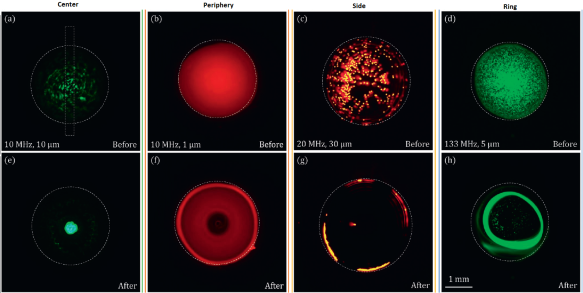Water is a simple element found in abundance throughout nature, and for many, its commonplace nature may mask its importance. Even a single droplet of water is of high value in the science world: when manipulated with sound waves, a water droplet can be used in a tremendous number of applications. For example, this simple technique can contribute to reducing the high costs of diagnosis tools, ensure the correct dosage of many drugs for effective treatment, and detect contaminants or pathogenic threats in food industry. This actuation of droplets using sound waves on the micron-scale is known as acoustofluidics.

Figure 1. Screenshots of the particle-laden sessile drops were captured before (a-d) and after (e-h) the SAW exposures.
The science behind the above-mentioned advances lies in the handling of droplets with surface acoustic waves (SAW), produced by an interdigitated transducer interacting with a sessile water droplet. This interaction leads the droplets to dissipate the energy absorbed from SAW, giving rise to acoustic streaming flow (ASF) and acoustic radiation force (ARF). As a result, sound waves with different amplitudes travel across the droplet and create micro-streams. Mixing, merging, and even sorting of the suspended particles are therefore enabled due to these micro-streams. To achieve this, an in-depth understanding of the generation of these micro-streams and their effect on the suspended particles are crucial for better controlled manipulation of these on-demand applications.
Luckily, scientists in the Flow Control Laboratory at KAIST have recently published a comprehensive study in Lab on a Chip on the fate of different sized microparticles inside a droplet of water actuated by SAW. In this work, for the first time, polystyrene microparticles were reported to go under four different unexplored modes at high frequencies. The elastic character of the polystyrene particles exhibits significantly different behaviors under SAW applied with different frequencies. For example, large particles were found to concentrate at the center of the droplet while the smaller ones form a ring structure around the periphery.

Figure 2. Separation of red 3 and green 5 µm polystyrene particles inside a (a) 5 and (b) 10 µm droplets.
Other intermediate modes include particle concentration at the side of the droplet and ring formation close to the droplet center: all dependent on the particle size, applied frequency, ASF, and ARF. Flow Control Laboratory further explored this interesting behavior using microparticles in the range of 1-30 µm at nominal frequencies of 10, 20, 80, and 133 MHz. Figure 1 shows before and after manipulation of the water droplets. Better yet, SAW applied at high frequencies allowed the separation of different-sized microparticles in a water droplet as seen in Figure 2.